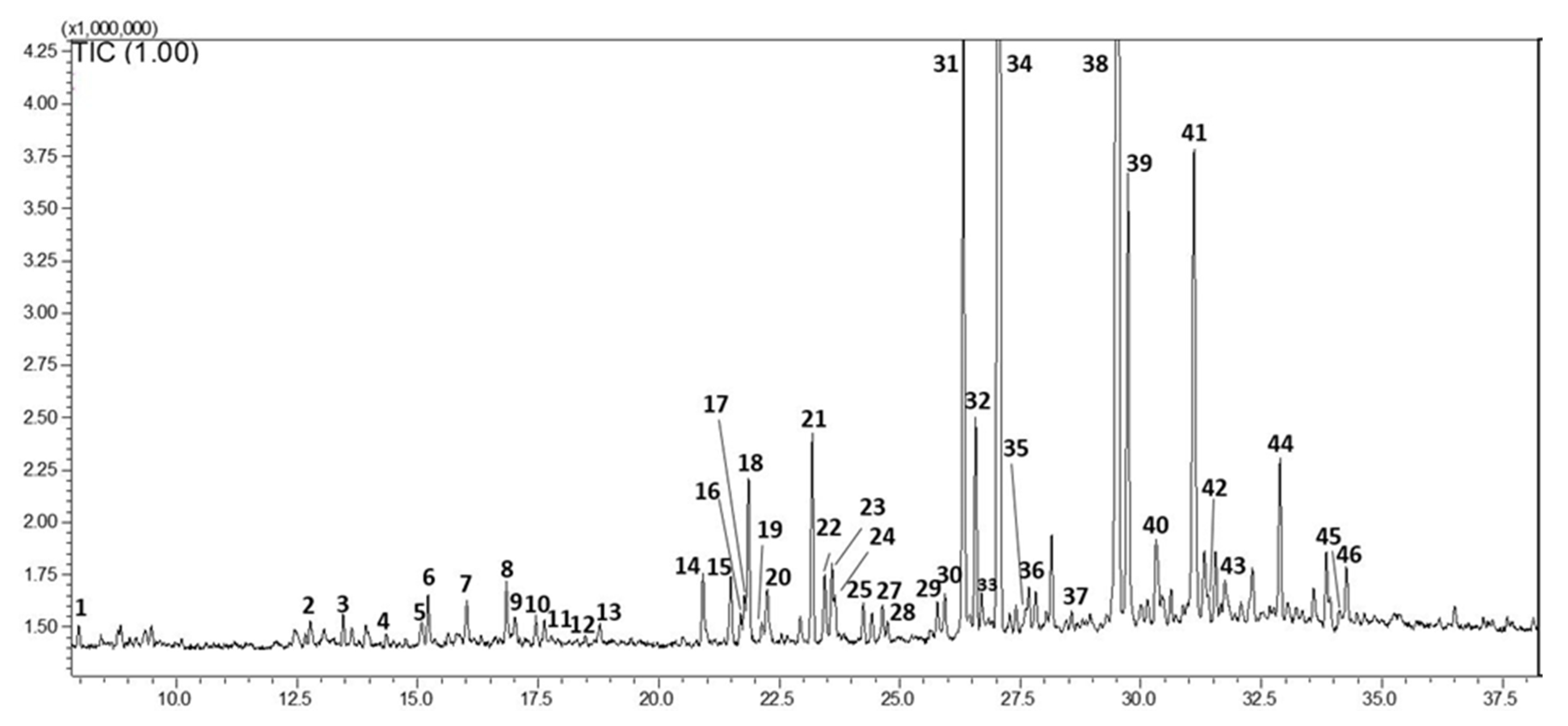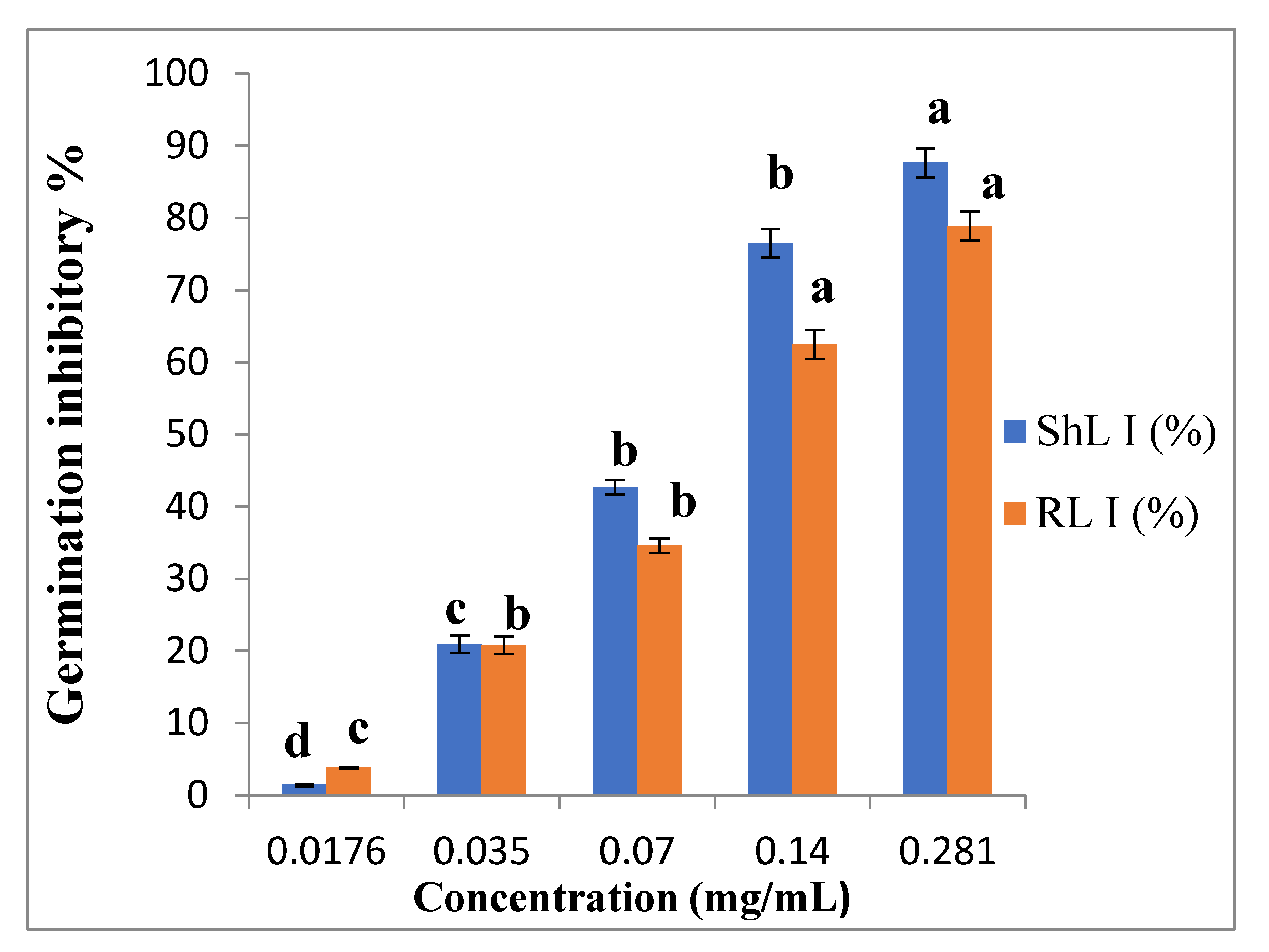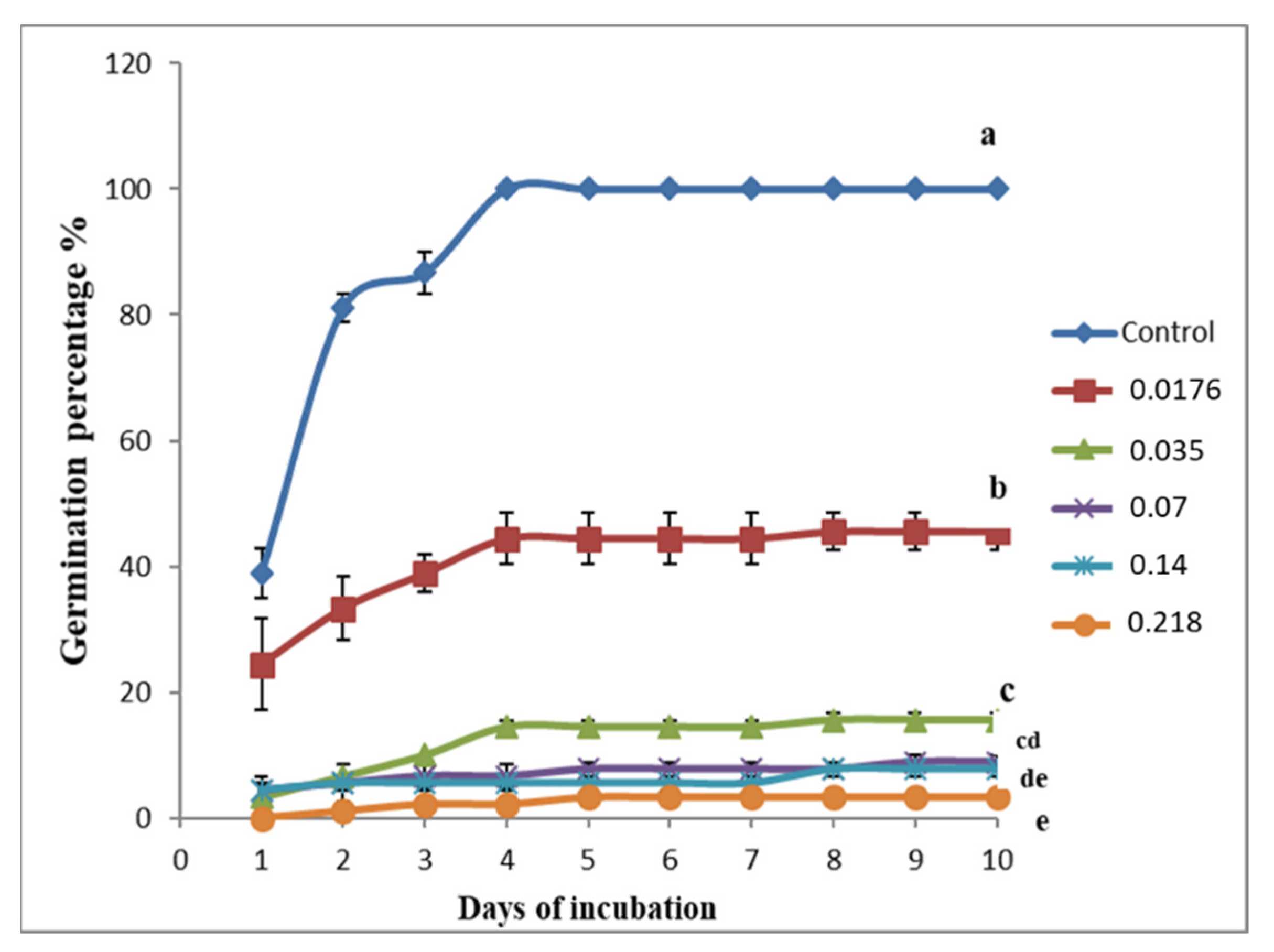Analysis of Volatiles in Senecio anteuphorbium Essential Oil with a Focus on Its Allelopathic Effect by Means of Gas Chromatography
Abstract
:1. Introduction
2. Materials and Methods
2.1. Plant Material
2.2. Extraction of the Essential Oil
2.3. Gas Chromatography
2.3.1. GC–FID Analysis
2.3.2. GC–MS Analysis
2.4. Allelopathic Activity
3. Results and Discussion
3.1. Quantitative Analysis
3.2. Allelopathic Activity
4. Conclusions
Author Contributions
Funding
Acknowledgments
Conflicts of Interest
References
- Brahim, M.A.S.; Fadli, M.; Hassani, L.; Boulay, B.; Markouk, M.; Bekkouche, K.; Abbda, A.; Ait Ali, M.; Larhsini, M. Chenopodium ambrosioides var. ambrosioides used in Moroccan traditional medicine can enhance the antimicrobial activity of conventional antibiotics. Ind. Crop. Prod. 2015, 71, 37–43. [Google Scholar] [CrossRef]
- Do Socorro Costa, M.; Santos Araújo, N.J.; Sampaio de Freitas, T.; Bezerra da Cunha, F.A.; do Amaral, W.; Deschamps, C.; Confortin, C.; Everson da Silva, L.; Douglas Melo Coutinho, H. GC–FID Analysis and Antibacterial Activity of the Calyptranthes concinna Essential Oil against MDR Bacterial Strains. Separations 2020, 7, 10. [Google Scholar] [CrossRef] [Green Version]
- Aghraz, A.; Albergamo, A.; Benameur, Q.; Salvo, A.; Larhsini, M.; Markouk, M.; Gervasi, T.; Cicero, N. Polyphenols contents, heavy metals analysis and in vitro antibacterial activity of extracts from Cladanthus arabicus and Bubonium imbricatum of Moroccan Origin. Nat. Prod. Res. 2020, 34, 63–70. [Google Scholar] [CrossRef] [PubMed]
- Bakkali, F.; Averbeck, S.; Averbeck, D.; Idaomar, M. Biological effects of essential oils—A review. Food Chem. Toxicol. 2008, 46, 446–475. [Google Scholar] [CrossRef] [PubMed]
- Mladenova, T.; Stoyanov, P.; Todorov, K.; Davcheva, D.; Kirova, G.; Deneva, T.; Gyuzeleva, D.; Mladenov, R.; Bivolarska, A. Phytochemical and Biological Traits of Endemic Betonica bulgarica (Lamiaceae). Separations 2021, 8, 11. [Google Scholar] [CrossRef]
- Bicchi, C.; Liberto, E.; Matteodo, M.; Sgorbini, B.; Mondello, L.; d’Acampora Zellner, B.; Costa, R.; Rubiolo, P. Quantitative analysis of essential oils: A complex task. Flavour Fragr. J. 2008, 23, 382–391. [Google Scholar] [CrossRef]
- Cicuzza, D.; Stäheli, D.S.; Nyffeler, R.; Eggli, U. Morphology and Anatomy Support a Reclassification of the African Succulent Taxa of Senecio S.L. (Asteraceae: Senecioneae). Haseltonia 2017, 23, 11–26. [Google Scholar] [CrossRef]
- Bellakhdar, J. La pharmacopée marocaine traditionnelle. In Médecine Arabe Ancienne et Savoirs Populaires; Ibis Press: Paris, France, 1997; pp. 1–764. [Google Scholar]
- Lounis, H.; Bergheim, I.; Bouhaimi, A.; Guigonis, J.M.; Belhamel, K. Anti-Inflammatory and antioxidant activities of Inula viscosa and Senecio anteuphorbium. Orient. Pharm. Exp. Med. 2018, 18, 225–236. [Google Scholar] [CrossRef]
- Ahmed, M.; Wardle, D.A. Allelopathic potential of vegetative and flowering ragwort (Senecio jacobaea L.) plants against associated pasture species. Plant Soil 1994, 164, 61–68. [Google Scholar] [CrossRef]
- Cruz-Silva, C.T.A.; Santorum, M.; Bini, F.V. Efeito alelopatico de extratos aquosos de Senecio brasiliensis (Spreng) Less sobre a germinação e o desenvolvimento de plântulas. Cultiv. Saber 2009, 2, 62–70. [Google Scholar]
- Singh, R.; Ahluwalia, V.; Singh, P.; Kumar, N.; Prakash Sati, O.; Sati, N. Antifungal and phytotoxic activity of essential oil from root of Senecio amplexicaulis Kunth. (Asteraceae) growing wild in high altitude-Himalayan region. Nat. Prod. Res. 2016, 30, 1875–1879. [Google Scholar] [CrossRef] [PubMed]
- Merino, F.J.Z.; Ribas, D.F.; Silva, C.B.D.; Duarte, A.F.S.; Paula, C.D.S.; Oliveira, M.D.; Miguel, O.G. A study of the phytotoxic effects of the aerial parts of Senecio westermanii Dusén (Asteraceae) on Lactuca sativa L. and Allium cepa L. seeds. Brazil. J. Pharm. Sci. 2018, 54, e17135. [Google Scholar] [CrossRef]
- Arancibia, L.A.; Henriquez, A.M.; Marchiaro, A.B. Senecio filaginoides DC as a Source of Allelopathic Agents and Its Possible Use as a Bioherbicide. Asian Res. J. Curr. Sci. 2020, 2, 101–107. [Google Scholar]
- Zhang, C.P.; Toshmatov, Z.O.; Zhou, S.X.; Li, W.J.; Zhang, C.; Shao, H. Chemical Composition and Phytotoxic Activity of Essential Oil from Senecio erucifolius. Chem. Nat. Compd. 2021, 57, 580–582. [Google Scholar] [CrossRef]
- Akula, R.; Ravishankar, G.A. Influence of abiotic stress signals on secondary metabolites in plants. Plant Signal. Behav. 2011, 6, 1720–1731. [Google Scholar] [CrossRef]
- Siyar, S.; Majeed, A.; Muhammad, Z.; Ali, H.; Inayat, N. Allelopathic effect of aqueous extracts of three weed species on the growth and leaf chlorophyll content of bread wheat. Acta Ecol. Sin. 2019, 39, 63–68. [Google Scholar] [CrossRef]
- Gniazdowska, A.; Bogatek, R. Allelopathic interactions between plants. Multi-site action of allelochemicals. Acta Physiol. Plant. 2005, 27, 395–407. [Google Scholar] [CrossRef]
- Jalaei, Z.; Fattahi, M.; Aramideh, S. Allelopathic and insecticidal activities of essential oil of Dracocephalum kotschyi Boiss. from Iran: A new chemotype with highest limonene-10-al and limonene. Ind. Crop. Prod. 2015, 73, 109–117. [Google Scholar] [CrossRef]
- Elhidar, N.; Nafis, A.; Kasrati, A.; Goehler, A.; Bohnert, J.A.; Abbad, A.; Mezrioui, N.E. Chemical composition, antimicrobial activities and synergistic effects of essential oil from Senecio anteuphorbium, a Moroccan endemic plant. Ind. Crop. Prod. 2019, 130, 310–315. [Google Scholar] [CrossRef]
- Costa, R.; De Fina, M.R.; Valentino, M.R.; Dugo, P.; Mondello, L. Reliable identification of terpenoids and related compounds by using Linear Retention Indices interactively with Mass Spectrometry search. Nat. Prod. Commun. 2007, 2, 413–418. [Google Scholar] [CrossRef]
- Costa, R.; Zellner, B.; Crupi, M.L.; De Fina, M.R.; Valentino, M.R.; Dugo, P.; Dugo, G.; Mondello, L. Gas Chromatography-Mass Spectrometry (GC–MS), Gas Chromatography-Olfactometry (GC-O) and Enantio-GC Investigation on the Essential Oil of Tarchonanthus camphoratus L. Flavour Fragr. J. 2008, 23, 40–48. [Google Scholar] [CrossRef]
- Kebbi, S.; Noman, L.; Demirtas, I.; Bensonici, C.; Adem, S.; Benayache, S.; Benayache, F.; Seghiri, R.; Gok, M. In Vitro Antioxidant and Anticholinesterase Activities of Senecio massaicus Essential Oil and Its Molecular Docking Studies as a Potential Inhibitor of COVID-19 and Alzheimer’s Diseases. J. Biolog. Act. Prod. Nat. 2021, 11, 380–394. [Google Scholar] [CrossRef]
- Irahal, I.N.; Lahlou, F.A.; Hmimid, F.; Errami, A.; Guenaou, I.; Diawara, I.; Kettani-Halabi, M.; Fahde, S.; Ouafik, L.; Bourhim, N. Identification of the chemical composition of six essential oils with mass spectroscopy and evaluation of their antibacterial and antioxidant potential. Flavour Fragr. J. 2021, 36, 465–476. [Google Scholar] [CrossRef]
- ElHawary, S.S.; Galal, A.E.; Yousif, M.F.; Kirollos, F.N. GC–MS and bioactivity of the essential oil of S. rowleyanus Jacobs. Pharmacog. Magaz. 2008, 4, 273–277. [Google Scholar]
- Thakuri, B.C.; Padalia, R.C.; Chanotiya, C.S.; Tiwari, A.; Mathela, C.S. Sesquiterpene rich oils from leaves and roots of S. rufinervis DC. J. Essent. Oil Res. 2008, 20, 435–436. [Google Scholar] [CrossRef]
- Nori-Shargh, D.; Raftari, S.; Deyhimi, F. Analysis of the essential oil of Senecio vernalis Waldst. & Kit. from Iran. Flavour Fragr. J. 2008, 23, 357–359. [Google Scholar] [CrossRef]
- Üçüncü, O.; Yayli, N.; Yaşar, A.; Terzioğlu, S.; Yayli, N. Chemical composition of the essential oils from flower, leaf, and stem of S. trapezuntinus Boiss. grown in Turkey. Nat. Prod. Commun. 2008, 3, 925–928. [Google Scholar] [CrossRef] [Green Version]
- Assaeed, A.; Elshamy, A.; El Gendy, A.E.N.; Dar, B.; Al-Rowaily, S.; Abd-ElGawad, A. Sesquiterpenes-Rich essential oil from above ground parts of Pulicaria somalensis exhibited antioxidant activity and allelopathic effect on weeds. Agronomy 2020, 10, 399. [Google Scholar] [CrossRef] [Green Version]
- Landi, M.; Misra, B.B.; Muto, A.; Bruno, L.; Araniti, F. Phytotoxicity, morphological, and metabolic effects of the sesquiterpenoid nerolidol on Arabidopsis thaliana seedling roots. Plants 2020, 9, 1347. [Google Scholar] [CrossRef]
- Hamrouni, L.; Hanana, M.; Amri, I.; Romane, A.E.; Gargouri, S.; Jamoussi, B. Allelopathic effects of essential oils of Pinus halepensis Miller: Chemical composition and study of their antifungal and herbicidal activities. Arch. Phytopathol. Plant Prot. 2015, 48, 145–158. [Google Scholar] [CrossRef]
- Candido, L.P.; Varela, R.M.; Torres, A.; Molinillo, J.M.G.; Gualtieri, S.C.J.; Macias, F.A. Evaluation of the allelopathic potential of leaf, stem and root extracts of Ocotea pulchella Nees et Mart. Chem. Biodiver. 2016, 13, 1058–1067. [Google Scholar] [CrossRef] [PubMed]
- Maraschin-Silva, F.; Aquila, M.E.A. Potencial alelopático de espécies nativas na germinação e crescimento inicial de Lactuca sativa L. (Asteraceae). Acta Bot. Brasil. 2006, 20, 61–69. [Google Scholar] [CrossRef]
- El-Gawad, A.A.; Elshamy, A.; El Gendy, A.E.N.; Gaara, A.; Assaeed, A. Volatiles profiling, allelopathic activity, and antioxidant potentiality of Xanthium strumarium leaves essential oil from Egypt: Evidence from chemometrics analysis. Molecules 2019, 24, 584. [Google Scholar] [CrossRef] [PubMed] [Green Version]



| Peak# | Group | Std. | Compound | RIexp | RIdb | Area % | RF | Wt% (g/100 g) |
|---|---|---|---|---|---|---|---|---|
| 1 | H | ✓ | α-Pinene | 933 | 933 | 0.16 ± 0.01 | 1.0 | 0.15 ± 0.01 |
| 2 | A | ✓ | 1-Octen-3-ol | 978 | 978 | 0.32 ± 0.03 | 1.3 | 0.38 ± 0.03 |
| 3 | A | ✓ | Linalool | 1099 | 1101 | 0.26 ± 0.01 | 1.3 | 0.31 ± 0.01 |
| 4 | K | ✓ | Isophorone | 1122 | 1123 | 0.12 ± 0.01 | 1.3 | 0.14 ± 0.01 |
| 5 | A | trans-Sabinol | 1139 | 1140 | 0.32 ± 0.01 | 1.3 | 0.38 ± 0.01 | |
| 6 | A | trans-Verbenol | 1142 | 1145 | 0.47 ± 0.02 | 1.3 | 0.56 ± 0.02 | |
| 7 | O | ✓ | trans-Linalool oxide | 1173 | 1174 | 0.49 ± 0.04 | 1.5 | 0.67 ± 0.05 |
| 8 | A | ✓ | p-Cymen-8-ol | 1187 | 1189 | 0.62 ± 0.01 | 1.3 | 0.73 ± 0.01 |
| 9 | A | ✓ | Myrtenol | 1199 | 1202 | 0.37 ± 0.02 | 1.3 | 0.44 ± 0.02 |
| 10 | K | ✓ | Verbenone | 1206 | 1208 | 0.28 ± 0.01 | 1.3 | 0.33 ± 0.01 |
| 11 | AL | ✓ | Safranal | 1208 | 1201 | 0.28 ± 0.01 | 1.4 | 0.36 ± 0.01 |
| 12 | K | ✓ | Pulegone | 1242 | 1241 | 0.10 ± 0.02 | 1.3 | 0.12 ± 0.02 |
| 13 | K | ✓ | Carvenone | 1255 | 1257 | 0.29 ± 0.02 | 1.3 | 0.34 ± 0.02 |
| 14 | A | ✓ | 4-Vinylguaiacol | 1308 | 1309 | 0.77 ± 0.02 | 1.3 | 0.91 ± 0.02 |
| 15 | H | Silphiperfol-5-ene | 1329 | 1326 | 0.70 ± 0.02 | 1.0 | 0.64 ± 0.02 | |
| 16 | H | ✓ | δ-Elemene | 1337 | 1335 | 0.28 ± 0.01 | 1.0 | 0.25 ± 0.01 |
| 17 | H | Presilphiperfol-7-ene | 1342 | 1339 | 0.39 ± 0.01 | 1.0 | 0.35 ± 0.01 | |
| 18 | A | ✓ | trans-p-Menth-6-en-2,8-diol | 1375 | 1375 | 1.55 ± 0.04 | 1.3 | 1.83 ± 0.05 |
| 19 | H | Silphiperfol-6-ene | 1382 | 1380 | 0.22 ± 0.02 | 1.0 | 0.20 ± 0.02 | |
| 20 | H | ✓ | β-Patchoulene | 1385 | 1383 | 0.66 ± 0.03 | 1.0 | 0.60 ± 0.02 |
| 21 | H | ✓ | α-Copaene | 1386 | 1385 | 1.72 ± 0.03 | 1.0 | 1.56 ± 0.03 |
| 22 | H | Modhephene | 1388 | 1384 | 0.71 ± 0.02 | 1.0 | 0.65 ± 0.01 | |
| 23 | H | ✓ | β-Elemene | 1391 | 1389 | 0.71 ± 0.01 | 1.0 | 0.65 ± 0.01 |
| 24 | H | α-Isocomene | 1393 | 1387 | 0.36 ± 0.02 | 1.0 | 0.33 ± 0.02 | |
| 25 | H | α-Gurjunene | 1409 | 1406 | 0.34 ± 0.01 | 1.0 | 0.31 ± 0.01 | |
| 26 | H | β-Isocomene | 1411 | 1407 | 0.29 ± 0.01 | 1.0 | 0.26 ± 0.01 | |
| 27 | H | ✓ | (Z)-Caryophyllene | 1415 | 1413 | 0.37 ± 0.02 | 1.0 | 0.34 ± 0.02 |
| 28 | H | ✓ | Guaia-6,9-diene | 1445 | 1444 | 0.21 ± 0.02 | 1.0 | 0.19 ± 0.01 |
| 29 | H | ✓ | α-Humulene | 1456 | 1454 | 0.41 ± 0.02 | 1.0 | 0.37 ± 0.02 |
| 30 | H | ✓ | Alloaromadendrene | 1460 | 1458 | 0.51 ± 0.02 | 1.0 | 0.46 ± 0.02 |
| 31 | H | Selina-4,11-diene | 1478 | 1476 | 5.59 ± 0.13 | 1.0 | 5.08 ± 0.11 | |
| 32 | H | ✓ | Germacrene D | 1482 | 1480 | 1.87 ± 0.02 | 1.0 | 1.70 ± 0.02 |
| 33 | H | Aristolochene | 1491 | 1487 | 0.55 ± 0.02 | 1.0 | 0.50 ± 0.01 | |
| 34 | H | ✓ | Bicyclogermacrene | 1501 | 1497 | 25.02 ± 0.09 | 1.0 | 22.75 ± 0.08 |
| 35 | A | Cubebol | 1520 | 1519 | 0.21 ± 0.02 | 1.3 | 0.25 ± 0.02 | |
| 36 | H | ✓ | δ-Cadinene | 1523 | 1518 | 0.39 ± 0.03 | 1.0 | 0.35 ± 0.03 |
| 37 | A | α-Elemol | 1552 | 1546 | 0.12 ± 0.01 | 1.3 | 0.14 ± 0.01 | |
| 38 | A | ✓ | Spathulenol | 1577 | 1576 | 21.37 ± 0.36 | 1.3 | 25.26 ± 0.42 |
| 39 | A | Fokienol | 1596 | 1596 | 4.96 ± 0.11 | 1.3 | 5.86 ± 0.13 | |
| 40 | A | 1,10-di-epi-Cubenol | 1616 | 1614 | 1.32 ± 0.10 | 1.3 | 1.56 ± 0.12 | |
| 41 | A | epi-γ-Eudesmol | 1627 | 1624 | 5.75 ± 0.17 | 1.3 | 6.80 ± 0.20 | |
| 42 | A | T-muurolol | 1652 | 1645 | 0.35 ± 0.04 | 1.3 | 0.41 ± 0.05 | |
| 43 | A | Cadin-4-en-10-ol | 1661 | 1659 | 1.04 ± 0.04 | 1.3 | 1.23 ± 0.04 | |
| 44 | A | Shyobunol | 1690 | 1686 | 1.74 ± 0.07 | 1.3 | 2.06 ± 0.08 | |
| 45 | A | β-Acoradienol | 1763 | 1760 | 0.25 ± 0.02 | 1.3 | 0.30 ± 0.02 | |
| 46 | K | Aristolone | 1765 | 1759 | 0.81 ± 0.02 | 1.3 | 0.96 ± 0.02 | |
| HYDROCARBONS | 41.46 ± 0.31 | 37.69 ± 0.38 | ||||||
| ALCOHOLS | 41.79 ± 0.47 | 49.38 ± 0.37 | ||||||
| KETONES | 1.60 ± 0.07 | 1.89 ± 0.08 | ||||||
| ALDEHYDES | 0.28 ± 0.02 | 0.36 ± 0.03 | ||||||
| OXIDES | 0.49 ± 0.02 | 0.67 ± 0.04 | ||||||
| EO Concentration (mg/mL) | Shoot Growth (cm) | Root Growth (cm) | Seedling Growth (cm) | GP (%) | MGT (Day) | GR (Units) | VI (Units) |
|---|---|---|---|---|---|---|---|
| Control | 2.34 ± 0.072 a | 3.41 ± 0.121 a | 5.61 ± 0.1 a | 100 a | 1.93 ± 0.14 a | 8.91 ± 1.47 a | 560.64 ± 12.47 a |
| 0.018 | 2.33 ± 0.12 a | 3.28 ± 0.21 a | 5.76 ± 0.33 a | 45.55 ± 6.94 b | 2.01 ± 0.33 b | 6.01 ± 0.57 b | 260.95 ± 12.23 b |
| 0.035 | 1.85 ± 0.12 b | 2.7 ± 0.16 a | 4.55 ± 0.21 b | 15.55 ± 1.92 c | 3.01 ± 0.52 c | 1.7 ± 0.02 c | 70.81 ± 7.17 c |
| 0.07 | 1.06 ± 0.1 b | 2.23 ± 0.21 b | 3.29 ± 0.16 b | 8.88 ± 1.92 cd | 3 ± 0.64 c | 1.05 ± 0.28 d | 27.01 ± 13.37 cd |
| 0.14 | 0.55 ± 0.02 c | 1.28 ± 0.04 b | 1.83 ± 0.03 c | 7.77 ± 1.92 de | 3.11 ± 0.51 c | 0.92 ± 0.15 d | 14.23 ± 1.89 d |
| 0.28 | 0.29 ± 0.02 d | 0.72 ± 0.01 c | 1.01 ± 0.02 c | 3.33 e | 3.33 ± 0.8 c | 0.4 ± 0.1 e | 3.36 ± 0.76 e |
| IC50 | 0.12 ± 0.01 | 0.15 ± 0.02 | - | - | - | - | - |
Publisher’s Note: MDPI stays neutral with regard to jurisdictional claims in published maps and institutional affiliations. |
© 2022 by the authors. Licensee MDPI, Basel, Switzerland. This article is an open access article distributed under the terms and conditions of the Creative Commons Attribution (CC BY) license (https://creativecommons.org/licenses/by/4.0/).
Share and Cite
Ouhaddou, S.; Aghraz, A.; Ben Bakrim, W.; Sissi, S.; Larhsini, M.; Markouk, M.; Bekkouche, K.; Arrigo, S.; Cicero, N.; Costa, R.; et al. Analysis of Volatiles in Senecio anteuphorbium Essential Oil with a Focus on Its Allelopathic Effect by Means of Gas Chromatography. Separations 2022, 9, 36. https://doi.org/10.3390/separations9020036
Ouhaddou S, Aghraz A, Ben Bakrim W, Sissi S, Larhsini M, Markouk M, Bekkouche K, Arrigo S, Cicero N, Costa R, et al. Analysis of Volatiles in Senecio anteuphorbium Essential Oil with a Focus on Its Allelopathic Effect by Means of Gas Chromatography. Separations. 2022; 9(2):36. https://doi.org/10.3390/separations9020036
Chicago/Turabian StyleOuhaddou, Soukaina, Abdellah Aghraz, Widad Ben Bakrim, Saida Sissi, Mustapha Larhsini, Mohamed Markouk, Khalid Bekkouche, Sara Arrigo, Nicola Cicero, Rosaria Costa, and et al. 2022. "Analysis of Volatiles in Senecio anteuphorbium Essential Oil with a Focus on Its Allelopathic Effect by Means of Gas Chromatography" Separations 9, no. 2: 36. https://doi.org/10.3390/separations9020036
APA StyleOuhaddou, S., Aghraz, A., Ben Bakrim, W., Sissi, S., Larhsini, M., Markouk, M., Bekkouche, K., Arrigo, S., Cicero, N., Costa, R., & Vadalà, R. (2022). Analysis of Volatiles in Senecio anteuphorbium Essential Oil with a Focus on Its Allelopathic Effect by Means of Gas Chromatography. Separations, 9(2), 36. https://doi.org/10.3390/separations9020036









